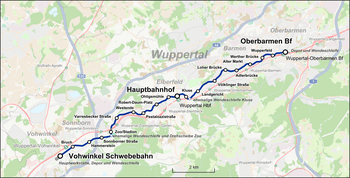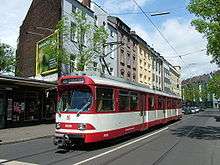Wuppertal Schwebebahn
The Wuppertaler Schwebebahn (Wuppertal Suspension Railway) is a suspension railway in Wuppertal, Germany.
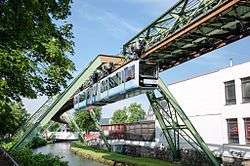 Schwebebahn between Adlerbrücke and Alter Markt | ||||||||||||||||||||||||||||||||||||||||||||||||||||||||||||||||||||||||||||||||||||||||||||||||||||||||||||||||||||||||||||||||||||||||||||||||||||||||||||||||||||||||||||||||||||||||||||||||||||||||||||||||||||||||||||||||||||||||||||||||||||||||||||||||||||||||||||||||
Railway logo | ||||||||||||||||||||||||||||||||||||||||||||||||||||||||||||||||||||||||||||||||||||||||||||||||||||||||||||||||||||||||||||||||||||||||||||||||||||||||||||||||||||||||||||||||||||||||||||||||||||||||||||||||||||||||||||||||||||||||||||||||||||||||||||||||||||||||||||||||
| Overview | ||||||||||||||||||||||||||||||||||||||||||||||||||||||||||||||||||||||||||||||||||||||||||||||||||||||||||||||||||||||||||||||||||||||||||||||||||||||||||||||||||||||||||||||||||||||||||||||||||||||||||||||||||||||||||||||||||||||||||||||||||||||||||||||||||||||||||||||||
|---|---|---|---|---|---|---|---|---|---|---|---|---|---|---|---|---|---|---|---|---|---|---|---|---|---|---|---|---|---|---|---|---|---|---|---|---|---|---|---|---|---|---|---|---|---|---|---|---|---|---|---|---|---|---|---|---|---|---|---|---|---|---|---|---|---|---|---|---|---|---|---|---|---|---|---|---|---|---|---|---|---|---|---|---|---|---|---|---|---|---|---|---|---|---|---|---|---|---|---|---|---|---|---|---|---|---|---|---|---|---|---|---|---|---|---|---|---|---|---|---|---|---|---|---|---|---|---|---|---|---|---|---|---|---|---|---|---|---|---|---|---|---|---|---|---|---|---|---|---|---|---|---|---|---|---|---|---|---|---|---|---|---|---|---|---|---|---|---|---|---|---|---|---|---|---|---|---|---|---|---|---|---|---|---|---|---|---|---|---|---|---|---|---|---|---|---|---|---|---|---|---|---|---|---|---|---|---|---|---|---|---|---|---|---|---|---|---|---|---|---|---|---|---|---|---|---|---|---|---|---|---|---|---|---|---|---|---|---|---|---|---|---|---|---|---|---|---|---|---|---|---|---|---|---|---|---|---|---|---|---|---|---|---|---|---|---|---|---|---|---|---|---|
| Locale | Wuppertal, Germany | |||||||||||||||||||||||||||||||||||||||||||||||||||||||||||||||||||||||||||||||||||||||||||||||||||||||||||||||||||||||||||||||||||||||||||||||||||||||||||||||||||||||||||||||||||||||||||||||||||||||||||||||||||||||||||||||||||||||||||||||||||||||||||||||||||||||||||||||
| Transit type | Suspension railway | |||||||||||||||||||||||||||||||||||||||||||||||||||||||||||||||||||||||||||||||||||||||||||||||||||||||||||||||||||||||||||||||||||||||||||||||||||||||||||||||||||||||||||||||||||||||||||||||||||||||||||||||||||||||||||||||||||||||||||||||||||||||||||||||||||||||||||||||
| Number of lines | 1 | |||||||||||||||||||||||||||||||||||||||||||||||||||||||||||||||||||||||||||||||||||||||||||||||||||||||||||||||||||||||||||||||||||||||||||||||||||||||||||||||||||||||||||||||||||||||||||||||||||||||||||||||||||||||||||||||||||||||||||||||||||||||||||||||||||||||||||||||
| Number of stations | 20 | |||||||||||||||||||||||||||||||||||||||||||||||||||||||||||||||||||||||||||||||||||||||||||||||||||||||||||||||||||||||||||||||||||||||||||||||||||||||||||||||||||||||||||||||||||||||||||||||||||||||||||||||||||||||||||||||||||||||||||||||||||||||||||||||||||||||||||||||
| Daily ridership | 82,000[1] | |||||||||||||||||||||||||||||||||||||||||||||||||||||||||||||||||||||||||||||||||||||||||||||||||||||||||||||||||||||||||||||||||||||||||||||||||||||||||||||||||||||||||||||||||||||||||||||||||||||||||||||||||||||||||||||||||||||||||||||||||||||||||||||||||||||||||||||||
| Operation | ||||||||||||||||||||||||||||||||||||||||||||||||||||||||||||||||||||||||||||||||||||||||||||||||||||||||||||||||||||||||||||||||||||||||||||||||||||||||||||||||||||||||||||||||||||||||||||||||||||||||||||||||||||||||||||||||||||||||||||||||||||||||||||||||||||||||||||||||
| Began operation | 1 March 1901 | |||||||||||||||||||||||||||||||||||||||||||||||||||||||||||||||||||||||||||||||||||||||||||||||||||||||||||||||||||||||||||||||||||||||||||||||||||||||||||||||||||||||||||||||||||||||||||||||||||||||||||||||||||||||||||||||||||||||||||||||||||||||||||||||||||||||||||||||
| Operator(s) | Wuppertaler Stadtwerke (WSW) | |||||||||||||||||||||||||||||||||||||||||||||||||||||||||||||||||||||||||||||||||||||||||||||||||||||||||||||||||||||||||||||||||||||||||||||||||||||||||||||||||||||||||||||||||||||||||||||||||||||||||||||||||||||||||||||||||||||||||||||||||||||||||||||||||||||||||||||||
| Technical | ||||||||||||||||||||||||||||||||||||||||||||||||||||||||||||||||||||||||||||||||||||||||||||||||||||||||||||||||||||||||||||||||||||||||||||||||||||||||||||||||||||||||||||||||||||||||||||||||||||||||||||||||||||||||||||||||||||||||||||||||||||||||||||||||||||||||||||||||
| System length | 13.3 km (8.3 mi) | |||||||||||||||||||||||||||||||||||||||||||||||||||||||||||||||||||||||||||||||||||||||||||||||||||||||||||||||||||||||||||||||||||||||||||||||||||||||||||||||||||||||||||||||||||||||||||||||||||||||||||||||||||||||||||||||||||||||||||||||||||||||||||||||||||||||||||||||
| ||||||||||||||||||||||||||||||||||||||||||||||||||||||||||||||||||||||||||||||||||||||||||||||||||||||||||||||||||||||||||||||||||||||||||||||||||||||||||||||||||||||||||||||||||||||||||||||||||||||||||||||||||||||||||||||||||||||||||||||||||||||||||||||||||||||||||||||||
Its full name is Anlage einer elektrischen Hochbahn (Schwebebahn), System Eugen Langen ("Electric Elevated Railway (Suspension Railway) Installation, Eugen Langen System").[2] It is the oldest electric elevated railway with hanging cars in the world and is a unique system.
Designed by Eugen Langen to sell to the city of Berlin,[3] the installation with elevated stations was built in Barmen, Elberfeld and Vohwinkel between 1897 and 1903; the first track opened in 1901. The Schwebebahn is still in use today as a normal means of local public transport, moving 25 million passengers annually (2008).[4]
The Schwebebahn runs along a route of 13.3 kilometres (8.3 mi), at a height of about 12 metres (39 ft) above the River Wupper between Oberbarmen and Sonnborner Straße (10 kilometres or 6.2 miles) and about 8 metres (26 ft) above the valley road between Sonnborner Straße and Vohwinkel (3.3 kilometres or 2.1 miles).[5][6] At one point the railway crosses the A46 motorway. The entire trip takes about 30 minutes.[6] The Schwebebahn operates within the VRR transport association and accepts tickets issued by the VRR companies.
Due to an accident in November 2018, the Schwebebahn was closed down for nearly nine months.[7] It re-opened on 1 August 2019.[8]
History
The Wuppertaler Schwebebahn had a forerunner: in 1824, Henry Robinson Palmer of Britain presented a railway system which differed from all previous constructions. It was a low single-rail suspension railway on which the carriages were drawn by horses. Friedrich Harkort, a Prussian industrial entrepreneur and politician, loved the idea. He saw big advantages for the transportation of coal to the early industrialised region in and around the Wupper valley. Harkort had his own steel mill in Elberfeld; he built a demonstration segment of the Palmer system and set it up in 1826 on the grounds of what is today the Wuppertal tax office. He tried to attract public attention to his railway plans.
On 9 September 1826, the town councillors of Elberfeld met to discuss the use of a "Palmer's Railway" from the Ruhr region, Hinsbeck or Langenberg, to the Wupper valley, Elberfeld, connecting Harkort's factories. Friedrich Harkort inspected the projected route with a surveyor and a member of the town council. The plans never went ahead because of protests from the transport branch and owners of mills that were not on the routes.
In 1887 the cities of Elberfeld and Barmen formed a commission for the construction of an elevated railway or Hochbahn. In 1894 they chose the system of the engineer Eugen Langen of Cologne, and in 1896 the order was licensed by the City of Düsseldorf.[6][9] In 2003, the Rhine Heritage Office (Rheinisches Amt für Denkmalpflege des Landschaftsverbandes Rheinland or LVR) announced the discovery of an original section of the test route of the Schwebebahn.
Construction on the actual Schwebebahn began in 1898, overseen by the government's master builder, Wilhelm Feldmann. On 24 October 1900, Emperor Wilhelm II participated in a monorail trial run.[6]
In 1901 the railway came into operation. It opened in sections: the line from Kluse to Zoo/Stadion opened on 1 March, the line to the western terminus at Vohwinkel opened on 24 May, while the line to the eastern terminus at Oberbarmen did not open until 27 June 1903.[5] Around 19,200 tonnes (18,900 long tons; 21,200 short tons) of steel were used to produce the supporting frame and the stations.[6] The construction cost 16 million gold marks. The railway was closed owing to severe damage during World War II, but reopened as early as 1946.[5]
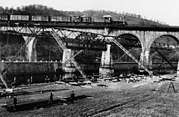 Construction of the Schwebebahn, 1900
Construction of the Schwebebahn, 1900 Werther Brücke station in 1913
Werther Brücke station in 1913 A GTW 72 train crossing an intersection
A GTW 72 train crossing an intersection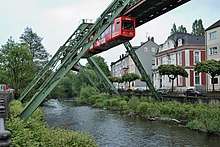 A train in Wuppertal in 2010
A train in Wuppertal in 2010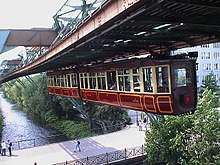 The Kaiserwagen
The Kaiserwagen Generation 15 train at Vohwinkel depot
Generation 15 train at Vohwinkel depot
Modernization
The Schwebebahn nowadays carries approximately 80,000[1] passengers through the city per weekday. Since 1997, the supporting frame has been largely modernized, and many stations have been reconstructed and brought up to date technically. Kluse station, at the theatre in Elberfeld, had been destroyed during the Second World War. This was also reconstructed during the modernization-phase. Work was planned to be completed in 2001; however a serious accident took place in 1999 which left five people dead and 47 injured. This, along with delivery problems, delayed completion. By 2004, the cost of the reconstruction work had increased from €380 million to €480 million.[10]
On 15 December 2009, the Schwebebahn suspended its operations for safety concerns; several of the older support structures needed to be renewed, a process that was completed on 19 April 2010.[11]
In 2012, the Schwebebahn was closed for significant periods to upgrade the line. The closing times were 7 to 21 July, 6 August to 22 October and weekends in September (15/16) and November (10/11).[12] The modernization was completed and the line fully reopened on 19 August 2013.
Post 2015 trains replacement
On 10 November 2011, Wuppertaler Stadtwerke signed a contract with Vossloh Kiepe to supply a new fleet of Generation 15 or GTW 15 trains to gradually replace the ageing GTW 72 fleet. The 31 new articulated cars were assembled by Vossloh España in Valencia, Spain,[13] featuring a light blue livery and having cushioned seating, air conditioning, information displays, LED lights, improved disabled access and induction motors with energy recovery during braking.[14] The first new train was commissioned by WSW in 2015[15][16] and entered regular passenger service on 18 December 2016,[17] at which point the line's power supply voltage was raised from 600 to 750 V.
The GTW 72 stock was gradually withdrawn from service as the new trains were introduced, the last of which operated immediately prior to the line's shutdown in November 2018. WSW announced it would not scrap any of the GTW 72 stock, but instead offer 21 of the vehicles for sale and three for free, as long as they remained in the city of Wuppertal.[18][19]
Stations
- Oberbarmen – eastern terminus
- Wupperfeld
- Werther Brücke
- Alter Markt
- Adlerbrücke (Opernhaus)
- Loher Brücke (Junior-Uni)
- Völklinger Straße
- Landgericht
- Kluse
- Hauptbahnhof (Döppersberg)
- Ohligsmühle
- Robert-Daum-Platz
- Pestalozzistraße
- Westende
- Varresbecker Straße
- Zoo/Stadion
- Sonnborner Straße
- Hammerstein
- Bruch
- Vohwinkel – western terminus
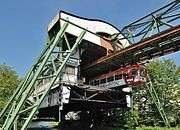 Werther Brücke station
Werther Brücke station Zoo/Stadion station
Zoo/Stadion station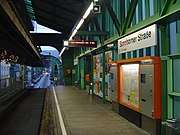 Sonnborner Straße station
Sonnborner Straße station
Technology
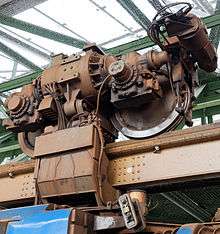
The cars are suspended from a single rail built underneath a supporting steel frame. The cars hang on wheels which are driven by multiple electric motors operating at 750 volts DC, fed from a live rail below the running rail.[20]
Until August 2019, the Schwebebahn used block signalling like other light- and heavy rail systems. Signals with red, green and yellow lights, present at every station, signalled the driver if the next block, usually continuing until the next station, was free or not. The yellow aspect was mostly used to warn about construction work ahead, while a blinking red light warned about more severe problems.
Today, the Schwebebahn uses the European Train Control System, allowing for shorter distances between trains.
The supporting frame and tracks are made out of 486 pillars and bridgework sections. When the line was originally built, Anton Rieppel, head of MAN-Werk Gustavsburg, designed the structural system, which he patented.[21] At each end of the line is a servicing depot, including a loop of track to allow the trains to be turned around.[6]
The current fleet consists of 31 articulated cars.[6] The cars are 24 metres long and have 4 doors. One carriage can seat 48 with approximately 130 standing passengers.[5] The top speed is 60 kilometres per hour (37 mph) and the average speed is 27 km/h (17 mph).[6]
The Kaiserwagen (Emperor's car), the original train used by Emperor Wilhelm II during a test ride on 24 October 1900, is still operated on scheduled excursion services, special occasions and for charter events.[6]
Incidents
- 15 January 1917
- A train rear-ended another train that had stopped unexpectedly in front of it between Oberbarmen and Wupperfeld, causing the trailing car of the stopped train to fall off the track. There were two minor injuries.[22] Subsequently, a safety device was developed to make derailments nearly impossible.[6]
- 21 July 1950
- The Althoff Circus organised a publicity stunt by putting a baby elephant on a train at Alter Markt station. As the elephant started to bump around during the ride, she fell out of the car and into the river Wupper.[23] The elephant, two journalists, and one passenger sustained minor injuries. After this jump, the elephant got the name Tuffi, meaning 'waterdive' in Italian. Both operator and circus director were fined after the incident.
- 11 September 1968
- A truck crashed into a pillar and caused a section of track to fall. There were no trains in the area at the time. This incident led to the use of concrete barriers around the pillar anchors.
- 25 March 1997
- A technical malfunction caused a rear-end collision in Oberbarmen station between a structure train and the Kaiserwagen. There were 14 injuries, but no derailment.
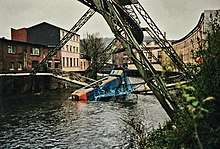
- 12 April 1999
- The line's only fatal incident occurred close to Robert-Daum-Platz station during maintenance work in the early morning hours of 12 April 1999. Workers had forgotten to remove a metal claw from the track on completion of scheduled night work. The first eastbound train of the day hit the claw at a speed of around 50 km/h (31 mph), derailed, and fell about 10 metres (33 ft) into the river Wupper, killing five passengers and injuring 47, some seriously. The salvage operation took three days and nights to complete. Eight weeks after the incident the Schwebebahn returned to operation. The cost of the damage was approximately 8 million marks.
- The judicial proceedings following the incident highlighted that the disaster was not caused by technical defects or system failure, but by negligence by workers having fallen behind in their schedule during the preceding night, and abandoning the work site hastily ten minutes before the train departed from the depot. Contributing to the circumstances was a lack of control of their activities by site supervisors.
- The Works Manager in charge of safety and the workers dealing with the steel claw at the time were acquitted of all charges by the District Court of Wuppertal. The site supervision personnel, having neglected their duties of control, were sentenced for involuntary manslaughter in 5 cases and bodily injury caused by negligence in 47 cases, but let off on probation with verdict 4 StR 289/01 dated 31 January 2002.[24]
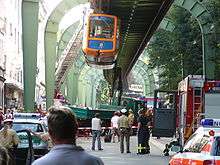
- 5 August 2008
- A train collided with a crane truck making deliveries under the track, causing a 10-metre-long (33 ft) tear in the floor of one of the cars. The truck driver was seriously injured, and the train driver and some passengers were treated for shock.[25]
- 17 October 2013
- A section of power rail 100 metres (330 ft) long fell from the track onto Federal Route 7, damaging several cars parked there and forcing closure of the road. The city's fire service had to rescue 70 passengers from a stopped train. No one was injured.[26]
- November 2018
- A support beam and part of the line partially collapsed due to a loose busbar, shutting down the line up until August 2019.
In popular culture
Literature
The Schwebebahn is alluded to in Theodor Herzl's 1902 utopian novel Altneuland (The Old New Land). For Herzl, the Schwebebahn was the ideal form of urban transport, and he imagined a large monorail built in its style in Haifa.[27]
Film
A sequence in Lyrical Nitrate, using film from between 1905 and 1915, features the Schwebebahn. Rüdiger Vogler and Yella Rottländer use images of the Schwebebahn in Wim Wenders's 1974 movie Alice in the Cities (Alice in den Städten). It also appears in the 1992 Dutch movie The Sunday Child (De Zondagsjongen) by Pieter Verhoeff, in Tom Tykwer's 2000 film The Princess and the Warrior (Der Krieger und die Kaiserin) and as a background and to a number of outdoor dance choreographies in another Wim Wenders film – 2011's Pina, and some dances are set inside the cars.
The Schwebebahn is both subject and title of video work by the Turner Prize-nominated artist Darren Almond. Produced in 1995, Schwebebahn is the first of three videos that constitute his Train Trilogy.
Other fiction
Some of the events in Le Feu de Wotan, a Belgian bande dessinée in the Yoko Tsuno series, take place in the Schwebebahn.
The denouement of the episode of the 1972 ITC TV series The Adventurer called "I'll Get There Sometime" takes place on the railway.
Gallery
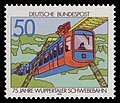 German stamp from 1976 to commemorate 75 years of the Schwebebahn
German stamp from 1976 to commemorate 75 years of the Schwebebahn 1913 depiction of the line
1913 depiction of the line Zoo station at night
Zoo station at night Wuppertaler Schwebebahn depot
Wuppertaler Schwebebahn depot- GTW 72 train interior
- GTW 72 train at a station
 Generation 15 train interior
Generation 15 train interior
See also
References
- "Facts & Figures". Schwebebahn. Retrieved 21 November 2015.
- https://web.archive.org/web/20110718195017/http://www.ag-sdd.de/ausgew_erw/rundgaenge/vollansicht/rundgang_5/spk_9.htm. Archived from the original on 18 July 2011. Retrieved 26 January 2011. Missing or empty
|title=(help) - "Die Große Erneuerung ist schon arg in Verzug" Archived 5 November 2014 at the Wayback Machine (in German), Frankfurter Allgemeine Zeitung, 25 August 1998.
- 2008 Annual report (in German), p. 44. Archived 15 February 2010 at the Wayback Machine
- Robert Schwandl. "Wuppertal". UrbanRail.net. Retrieved 21 November 2015.
- "Uni Wuppertal – Wuppertal's Suspension Railway: overview and history". Archived from the original on 8 October 2006. Retrieved 20 February 2007.
- Connolly, Kate (1 August 2019). "World's oldest electric suspension train reopens in Germany". The Guardian. Retrieved 1 August 2019.
- "Da schwebt sie wieder!". Spiegel. 1 August 2019. Retrieved 1 August 2019. (in German)
- "Die Geschichte der Schwebebahn" (in German). Schwebebahn. Retrieved 21 November 2015.
- Von Andreas Spiegelhauer (18 March 2009). "Schwebebahn-Ausbau: Betrug bei Millionen-Hilfe?". Westdeutsche Zeitung (in German).
- WSW-Online: Altgerüst muss verstärkt werden -Schwebebahn außer Betrieb Archived 2 January 2010 at the Wayback Machine (in German).
- "Archived copy". Archived from the original on 12 February 2013. Retrieved 10 August 2012.CS1 maint: archived copy as title (link)
- "Generation 15 trainsets enter service in Wuppertal". Metro Report. Retrieved 16 July 2019.
- "Vehicles – From the prototype to the modern suspension railway". Schwebebahn.de/en. Retrieved 23 March 2018.
- Wuppertal begrüßt die neue Schwebebahn. Website der Westdeutschen Zeitung, 14. November 2015, abgerufen am 15. November 2015.
- Erster Wagen in Vohwinkel – Die neue Schwebebahn ist da. Website der Rheinischen Post, 14. November 2015, abgerufen am 15. November 2015.
- "Suspension Railway In Wuppertal: Story Of A Landmark". You Tube. Retrieved 23 March 2018.
- Wuppertal verschenkt und verkauft Schwebebahn-Wagen. Website der Rheinischen Post, 13. August 2015, abgerufen am 5. September 2015.
- Wuppertal verschenkt drei Schwebebahnen: Rest ist zu kaufen auf t-online.de, 13. August 2015, abgerufen am 5. September 2015.
- "Wuppertaler Stadtwerke AG – English". Archived from the original on 9 October 2006. Retrieved 20 February 2007.
- "Unbenanntes Dokument". rheinische-industriekultur.de (in German).
- "Schwebebahn in Wuppertal und mehr". Retrieved 21 November 2015.
- Article in Westdeutsche Zeitung, March 2009
- "BGH 4 StR 289/01 - 31. Januar 2002 (LG Wuppertal)". hrr-strafrecht.de (in German).
- "Rettung aus der Luft: Wuppertaler Schwebebahn kollidiert mit Kran". Spiegel Online (in German). Hamburg, Germany. 5 August 2008.
- "Nach Schwebebahn-Unfall in Wuppertal ermittelt jetzt der Staatsanwalt". DerWesten.de (in German). WAZ Mediengruppe. 18 October 2013. Retrieved 21 November 2015.
- "Monorails were a great idea in 1902, and they're a great idea now". Yesterday's Salad. 3 January 2007.
External links
| Wikimedia Commons has media related to Wuppertaler Schwebebahn. |
- Official website

- WSW Mobility
- Wuppertal at UrbanRail.net
- The Monorail Society
